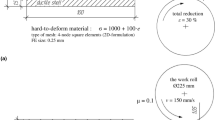Abstract
Large cylindrical shell rolling is an advanced plastic-forming technique that has unequal speed and radius of both its upper and lower rolls. A theoretical model for a large cylindrical shell rolling that is based on the slab method is proposed, in which the non-uniform normal and shear stresses that act on the vertical sides are considered. A mixed friction model of combined Coulomb and sticking friction is used to present interface friction, to improve the accuracy of the proposed model. The rolling pressure, rolling force, and torque as well as friction stress can be rapidly and easily calculated through the proposed model at different rolling conditions. The predicted rolling force is consistent with the experimental result. The research results provide valuable guidelines for both the design and optimization of rolling product, process, and equipment.
Similar content being viewed by others
References
W. Johnson and G. Needham, Experiments on ring rolling, International Journal of Mechanical Sciences, 10 (2) (1968) 95–113.
A. G. Mamalis, W. Johnson, and J. B. Hawkyard, Pressure distribution, roll force and torque in cold ring rolling, Journal of Mechanical Engineering Science, 18 (4) (1976) 196–209.
J. B. Hawkyard, W. Johnson, J. Kirkland, and E. Appleton, Analyses for roll force and torque in ring rolling with some supporting experiments, International Journal of Mechanical Sciences, 15 (11) (1973) 873–893.
J. S. Ryoo, D. Y. Yang, and W. Johnson, Lower upperbound analysis of the ring rolling process by using force polygon diagram and dual velocity field, Advanced Technology Plasticity, 2 (1984) 1292–1298.
Y. M. Zhao and D. S. Qian, Effect of rolling ratio on groovesection profile ring rolling, Journal of Mechanical Science and Technology, 24 (8) (2010) 1679–1687.
L. Y. Li, H. Yang, L. G. Guo, and Z. C. Sun, Research on interactive influences of parameters on T-shaped cold ring rolling by 3d-FE numerical simulation, Journal of Mechanical Science and Technology, 21 (10) (2007) 1541–1547.
X. K. Wang and L. Hua, Analysis of guide modes in vertical hot ring rolling and their effects on the ring’s dimensional precision using FE method, Journal of Mechanical Science and Technology, 25 (3) (2011) 655–662.
L. Hua, D. S. Qian, and L. B. Pan, Analysis of plastic penetration in process of groove-ball section ring rolling, Journal of Mechanical Science and Technology, 22 (7) (2008) 1374–1382.
A. Ktari, Z. Antar, N. Haddar, and K. Elleuch, Modeling and computation of the three-roller bending process of steel sheets, Journal of Mechanical Science and Technology, 26 (1) (2012) 123–128.
S. H. Lee, G. H. Song, S. J. Lee, and B. M. Kim, Study on the improved accuracy of strip profile using numerical formula model in continuous cold rolling with 6-high mill, Journal of Mechanical Science and Technology, 25 (8) (2011) 2101–2109.
M. Salimi and F. Sassani, Modified slab analysis of asymmetrical plate rolling, International Journal of Mechanical Sciences, 44 (9) (2002) 1999–2023.
Y. M. Hwang and G. Y. Tzou, Stress analysis of asymmetrical cold rolling of clad sheet using the slab method, Journal of Materials Engineering and Performance, 5 (5) (1996) 621–631.
G. Y. Tzou and M. N. Huang, Analytical modified model of the cold bond rolling of unbounded double-layers sheet considering hybrid friction, Journal of Materials Processing Technology, 140 (1–3) (2003) 622–627.
S. C. Pan, M. N. Huang, G. Y. Tzou and S. W. Syu, Analysis of asymmetrical cold and hot bond rolling of unbounded clad sheet under constant shear friction, Journal of Materials Processing Technology, 177 (1–3) (2006) 114–120.
S. C. Pan, G. Y. Tzou, M. N. Huang and C. W. Huang, Analytical model of asymmetrical cold bond rolling of twolayer unbounded clad sheets under coulomb friction, Steel Research International, 79 (2008) 734–741.
S. H. Zhang, D. W. Zhao, C. R. Gao and G. D. Wang, Analysis of asymmetrical sheet rolling by slab method, International Journal of Mechanical Sciences, 65 (1) (2012) 168–176.
A. Parvizi, K. Abrinia and M. Salimi, Slab analysis of ring Rolling assuming constant shear friction, Journal of Materials Engineering and Performance, 20 (9) (2011) 1505–1511.
N. Anjami and A. Basti, Investigation of rolls size effects on hot ring rolling process by coupled thermo-mechanical 3D-FEA, Journal of Materials Processing Technology, 210 (10) (2010) 1364–1377.
G. Y. Tzou, Relationship between frictional coefficient and friction factor in asymmetrical sheet rolling, Journal of Materials Processing Technology, 86 (1–3) (1998) 271–277.
S. W. Chen, H. M. Liu, Y. Peng and J. L. Sun, Strip layer method for simulation of the three-dimensional deformations of large cylindrical shell rolling, International Journal of Mechanical Sciences, 77 (2013) 113–120.
Y. Yea, Y. Ko, N. Kima and J. Lee, Prediction of spread, pressure distribution and roll force in ring rolling process using rigid-plastic finite element method, Journal of Materials Processing Technology, 140 (1–3) (2003) 478–486.
Author information
Authors and Affiliations
Corresponding author
Additional information
Recommended by Associate Editor Dae-Cheol Ko
Liu Hongmin received his Doctor Degree in Metallurgical Machinery in Northeast Heavy Machinery Institute, China, on 1988. He is now a professor at Yanshan University, China. His research interests include rolling theory and profile control.
Rights and permissions
About this article
Cite this article
Chen, S., Liu, H., Peng, Y. et al. Slab analysis of large cylindrical shell rolling considering mixed friction. J Mech Sci Technol 28, 4753–4760 (2014). https://doi.org/10.1007/s12206-014-1042-1
Received:
Revised:
Accepted:
Published:
Issue Date:
DOI: https://doi.org/10.1007/s12206-014-1042-1



